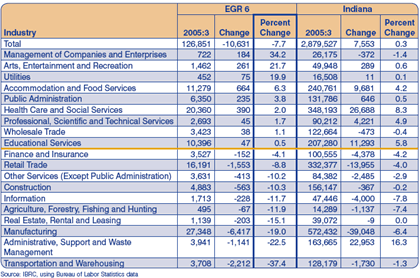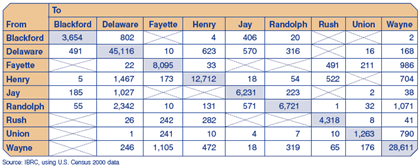Regional Perspective: Economic Growth Region 6
Economic Growth Region (EGR) 6 is located in east-central Indiana and consists of nine counties that make up 5.5 percent of the state's population: Blackford, Delaware, Fayette, Henry, Jay, Randolph, Rush, Union and Wayne counties. Of the nearly 345,000 people who live in EGR 6, 19.4 percent reside in Muncie (Delaware County), the region's largest city and home to Ball State University. Richmond (Wayne County), New Castle (Henry County) and Connersville (Fayette County) are the only other cities in the region that make up more than 2 percent of the region's population, with 10.9 percent, 5.5 percent and 4.2 percent, respectively. (see Figure 1)
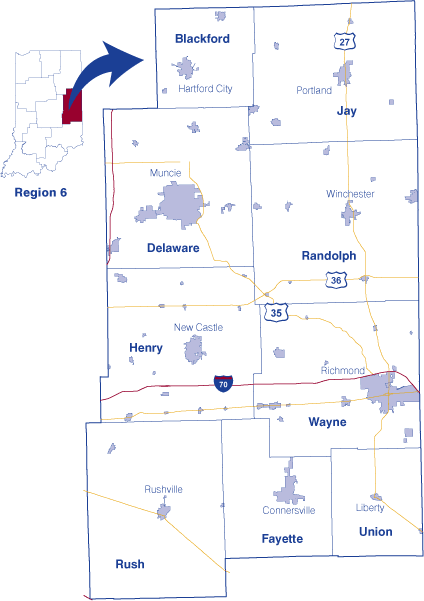
Figure 1: EGR 6 Population Distribution
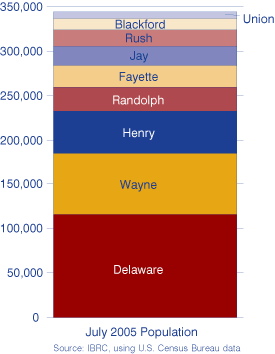
While the state of Indiana has seen an increase in population of nearly 3 percent from July 2000 to July 2005, the nine-county region that makes up EGR 6 experienced a decline of 2.2 percent (7,671 people). The region actually grew in terms of natural increases (births minus deaths); however, migration patterns show that six of the nine counties have not experienced net in-migration for the past five years (see Figure 2).
Figure 2: Net Migration of County Population within EGR 6, July of Each Year
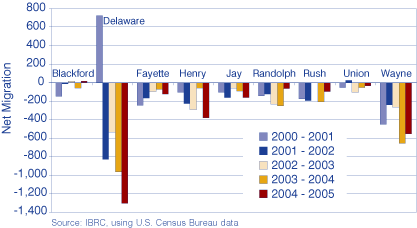
Jobs and Wages
Region 6 jobs have taken a nosedive over the past four years, especially compared to the state. From the third quarter of 2001 to the same time in 2005, EGR 6 experienced a loss of 10,631 jobs (a 7.7 percent decrease); Indiana managed to gain more than 7,500 jobs for a 0.3 percent increase over that same period of time. Nine major industry classifications actually posted gains in the region, but these gains were not nearly enough to offset the other ten industries' losses (see Table 1). As for the job losses at the regional level, manufacturing made up the majority (more than 6,400) but remains the largest major industry sector in the region with 21.6 percent of all jobs, compared to 19.9 percent at the state level.
Table 1: Change in Jobs in EGR 6 and Indiana, 2001:3 to 2005:3
One possible explanation for the decrease in the region's population and jobs could be related to the wages paid across all industry sectors. The only industry in which Region 6 paid more than the state was the health care and social services industry, and that was only by an average of $1 per week. Even the management of companies and enterprises industry, which paid the highest average weekly wages in the region, paid $44 less per week than Indiana overall. The biggest difference in wages was in the professional, scientific and technical services industry, with Indiana paying a higher average weekly wage by $278 (see Figure 3). This industry classification includes jobs such as legal, accounting, engineering and advertising services.
Figure 3: Average Weekly Wages, 2005:3
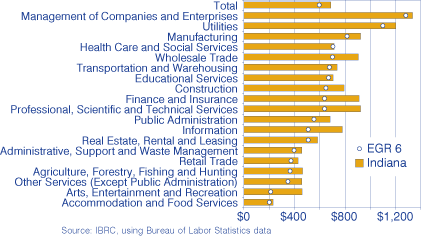
Commuting
Of the approximately 143,200 people in the EGR 6 workforce (those who work in the region, but live anywhere), 94 percent were also residents, according to Census 2000 data. There are just over 27,300 workers who live in Region 6 but commute elsewhere for work. Where are these workers going? Not surprisingly, the counties nearest the region are receiving the most workers (see Figure 4). Of Indiana's 92 counties, eight received at least 1,000 workers from the region and 28 did not receive workers from EGR 6 at all. Another 3,756 workers were sent out of state to neighboring Ohio. Meanwhile, only one county outside the region (neighboring Madison County) sent more than 1,000 workers into EGR 6 to work.
Figure 4: EGR 6 Commuting Patterns

As far as intra-regional commuting is concerned, Delaware County received the most workers from fellow EGR counties with more than 5,900 workers coming in from the other eight counties. At the same time, Union County (the smallest county in both population and area) received the fewest workers from the rest of the region (see Table 2). Randolph County sent out more than any other regional county, over half of which went to Delaware County; and Rush County contributed the fewest workers to the rest of the region.
Table 2: Intra-Regional Commuting, 2000
Conclusion
All in all, Economic Growth Region 6 has been struggling over the past few years. Most likely, the decrease in jobs has contributed to the decrease in population. Meanwhile, lower average wages compared to the rest of the state aren't likely to attract more people into the area, resulting in the higher number of people leaving the region to find work compared to those coming into EGR 6.
Molly Marlatt, Research Associate
Indiana Business Research
Center, Kelley School of Business, Indiana University

